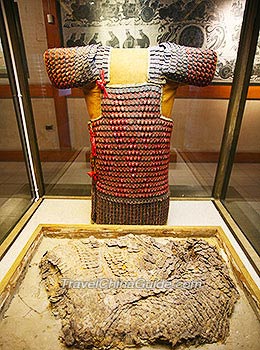Weaponry of Iron Age
 |
| Iron Armour |
Cannon, or stonejacker, appeared in the late Eastern Han Dyansty (25-220) and thrived in the Three Kingdoms Period (220- 280), made of iron and utilising stone cannonballs. When enemies came, the defenders would place the cannons atop the city gate. It recurred to the leverage and threw the huge stone over the wall in a way of parabola thus crushing the aggressors. This is still reflected in the Chinese chess - the chess piece representing the cannon ('Pao' in Chinese) still follows the regulation of attacking another chess piece only when there is the third one in between.
With the rise of cavalry during the Western Han Dynasty an oblong shield appeared that soldiers could hold one handed. During the Song Dynasty (960-1279), it was bound to the left forearm of a cavalry and changed shape to circular. Till the Northern and Southern Dynasty (386 - 589), a long hexagon one prevailed with the shield face introverting vertically like a leaf. When in the battle, it could either be hand held or be placed on the ground with the support of a stick.
| Iron Cannons |
With the development of steel armour, not only soldiers but horses wore the armour. Thus the halberd which functioned mainly to thrust and hook lost its place on the battle field. Spears evolved into lances, and were used exclusively by cavalry, offering a high power of penetration.
The Han Dynasty is the key period of the development of Chinese warships, no matter what the scale. Oars in the Western Han, rudder in the Eastern Han, both were the brilliant achievements. Scull changed the way of thrashing from front-behind to left-right and improved the efficiency, which was the precursor of modern helix thrusters. Helm made up the flexibility of steering sailing course of oar and paved the way for European exploration. In the Jin Dynasty (265 - 420), warships of large scale stood out. In the records there had been a ship combining many hulls with the length and breadth of 180 meters and could hold more than 2,000 people on board. Atop was fixed wooden city and horses could gallop through the four city gates. In the Sui Dynasty (581 - 618), an extremely large ship over 30 meters high was built that could hold 800 people. Until the Southern Song Dynasty nearly all the armies used warships. Examples of 110 meters with tower, skirt-board and wheel-oars are recorded.
|
|
- Last updated on Mar. 14, 2022 -